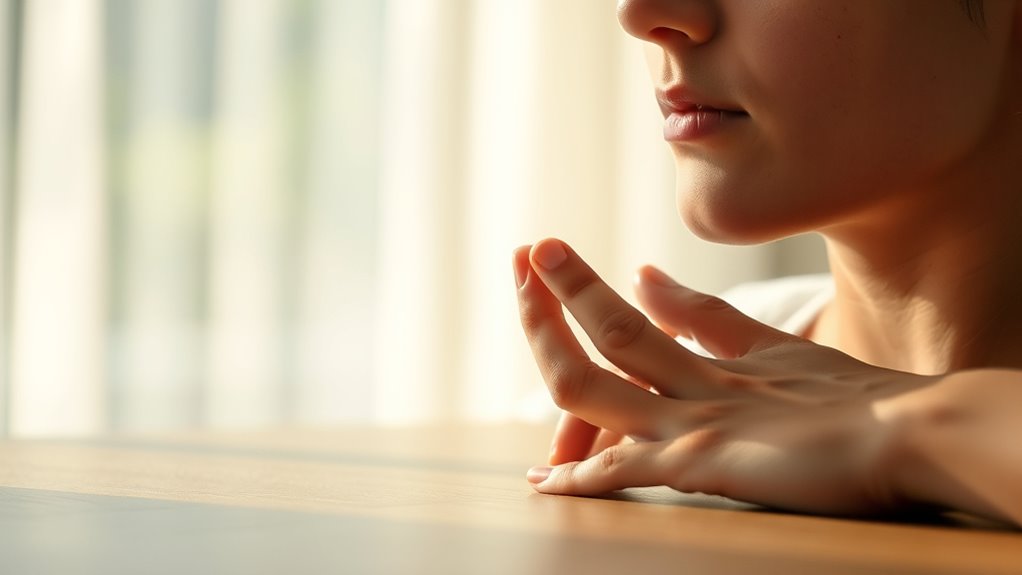When panic strikes, use box breathing to quickly calm yourself anywhere. Inhale through your nose for a count of four, then hold your breath for four counts. Exhale gently for four counts, releasing tension, and hold again for four counts before starting the cycle over. Focus on each step, staying present and steady. Practicing this simple technique helps control anxiety and calms your nervous system. Keep going to discover more effective ways to manage panic anytime you need.
Key Takeaways
- Follow the four-step cycle: inhale for four counts, hold for four, exhale for four, hold for four.
- Practice anywhere—at your desk, in a waiting room, or during stressful moments.
- Focus on steady, unhurried breathing to regulate your nervous system and reduce panic symptoms.
- Use box breathing proactively to prevent escalation or reactively during early signs of panic.
- Regular practice builds resilience, enhances emotional control, and helps you respond calmly in stressful situations.

When panic sets in, it can feel overwhelming and hard to control, but practicing box breathing offers a simple yet effective way to calm your mind and body. This technique is a form of mindfulness exercise that helps you regain focus and reduce anxiety quickly, no matter where you are. By incorporating box breathing into your routine, you can access a powerful stress reduction technique that brings balance and clarity during moments of distress. The core idea of box breathing is to breathe in a steady, controlled manner, following a four-step pattern that mimics the sides of a box. First, you inhale slowly through your nose for a count of four. During this inhale, focus your attention on the sensation of air filling your lungs. Next, hold your breath for the same four-count, keeping your mind present and free of racing thoughts. Then, exhale gently through your mouth or nose for four counts, releasing tension with each breath out. Finally, hold your breath again for four counts before starting the cycle over. This rhythmic pattern helps regulate your nervous system, reducing feelings of anxiety and stress. Controlling your nervous system through steady breathing can help prevent panic from escalating. You can do this exercise anywhere — at your desk, in a waiting room, or even in a crowded place. The key is to maintain a steady, unhurried pace and stay mindful of each breath. As you practice, you’ll notice your heart rate slowing and your mind clearing. Many find that regular use of mindfulness exercises like box breathing builds resilience against panic attacks and enhances overall emotional well-being. It’s a simple stress reduction technique that can be integrated into your daily routine or used reactively when panic hits. The beauty of box breathing lies in its versatility and ease of use. You don’t need special equipment or a quiet room — just your breath and a few moments of intentional focus. This technique trains you to stay present, reducing the tendency to spiral into negative thought patterns. Over time, you’ll become more skilled at recognizing the early signs of panic and applying box breathing as a quick, effective intervention. It’s an empowering way to take control of your anxiety, giving you a practical tool to manage your mental health in real-time. With practice, this simple exercise can become a go-to stress reduction technique, helping you stay centered no matter what challenges come your way.
Frequently Asked Questions
Can Box Breathing Help With Chronic Anxiety?
Chronic anxiety can be challenging, but practices like box breathing can offer relief. It helps you focus on your breath, similar to mindfulness meditation, which promotes awareness and calmness. By regularly practicing box breathing, you can reduce stress levels and manage anxiety more effectively. This simple technique is accessible anywhere, making it a useful tool for stress reduction and calming your mind during anxious moments.
How Long Should I Practice Box Breathing Daily?
Imagine your breath as a gentle stream, flowing steadily. You should practice box breathing for about 5 to 10 minutes daily, like tending to a delicate garden. Focus on consistent practice frequency, ideally once or twice a day. Keep your breathing duration balanced—inhale, hold, exhale, hold for equal counts. Over time, this rhythm helps calm your mind, building resilience against anxiety and fostering a sense of peace.
Is Box Breathing Effective for Children or Teenagers?
You might wonder if box breathing helps children or teenagers. It can be effective for child relaxation and managing teen stress, as it teaches calmness and focus. Kids and teens often respond well to simple breathing techniques, especially when guided. Just make certain the practice is age-appropriate and done in a comfortable setting. With consistent practice, box breathing can become a useful tool for young people to handle anxiety and stay centered.
Are There Any Risks or Side Effects Associated With Box Breathing?
You might wonder if there are risks or side effects with box breathing. Risks overview shows that for most people, it’s safe and beneficial. However, some may experience dizziness or discomfort if they breathe too quickly or hold their breath too long. Always listen to your body, especially if you have respiratory issues or anxiety, and stop if you feel lightheaded or uncomfortable. Proper guidance minimizes any potential side effects.
How Quickly Can I Expect to See Results From Box Breathing?
You might notice some mindfulness benefits and a calmer mindset after just a few minutes of practicing breathing techniques like box breathing. While individual results vary, many feel increased relaxation and reduced stress within days. Consistent practice enhances these benefits over time, helping you manage panic more effectively. Keep practicing regularly, and you’ll likely see quicker improvements in your overall stress response and emotional resilience.
Conclusion
By practicing box breathing, you can pause the panic, regain control, and restore calm. By focusing on your breath, you strengthen your mind, soothe your body, and quiet your thoughts. By making this technique a habit, you empower yourself to face anxiety with confidence, resilience, and clarity. Remember, with each breath, you take a step toward peace, a moment of stillness, and a sense of mastery over your emotions.









